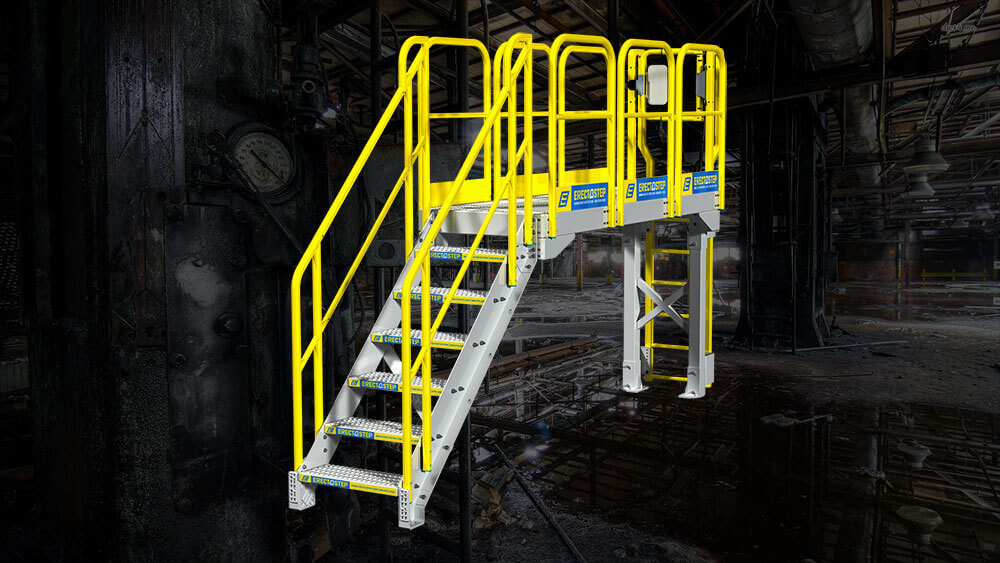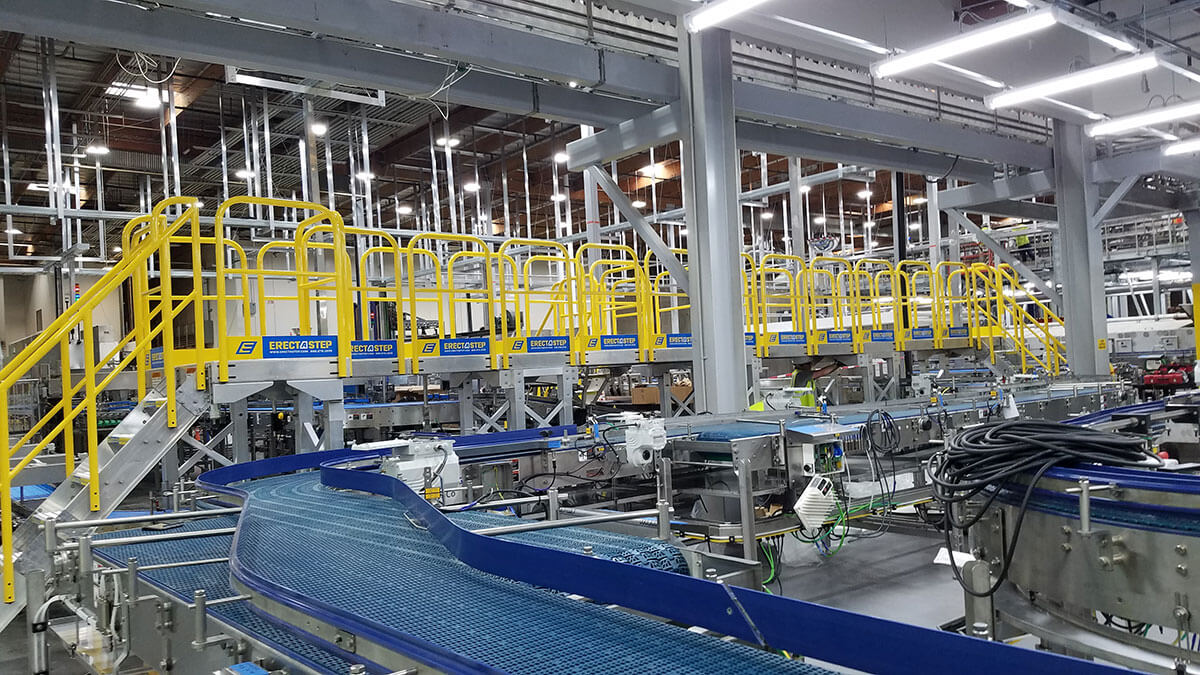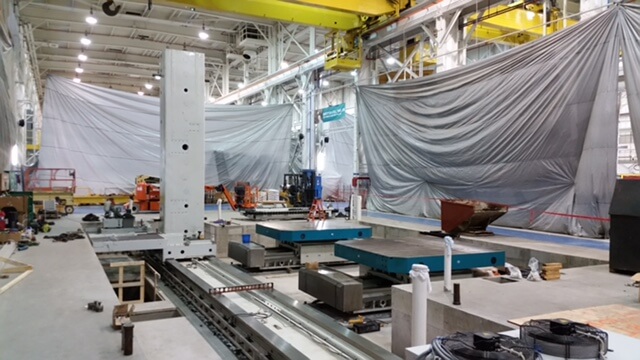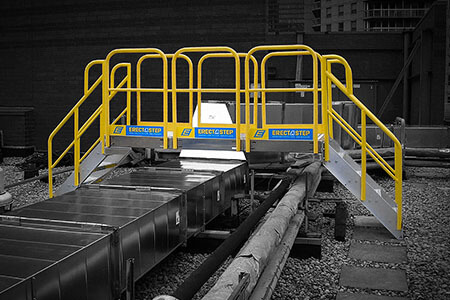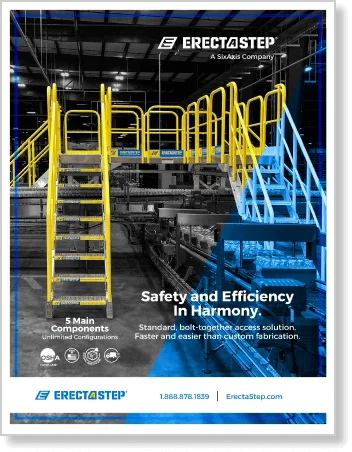Better strike a pose safely using a stable catwalk or access system, than be sorry when accidents in your manufacturing or construction site happen!
As opposed to the more popular meaning of ‘catwalk’ as the ramp where models sashay garbed in high fashion, in the industrial parlance, a catwalk pertains to a ‘walkway’ that facilitates the movement of workers and equipment from point A to point B. So, instead of striking a pose for posterity, industrial catwalks ensure worker safety and convenience. Access catwalks of the industrial-type enable safe access to hard-to-reach areas that are at an elevation. These help workers access all kinds of valves, switches, and equipment that might otherwise be very difficult and dangerous to reach. More than anything else, an industrial catwalk is a great enabler in an industrial setting.
Typically, catwalks function as aisles or walkways that allow access within the confines of an industrial building or a warehouse. These can help workers to deposit or remove goods and inventory from steel shelves or rivet racks. In the case of manufacturing operations, these access catwalks make extended access possible throughout the manufacturing operations area. This is very important because manufacturing operations usually need a network of pathways, not only on the floor but also at an elevation to access machines and materials.
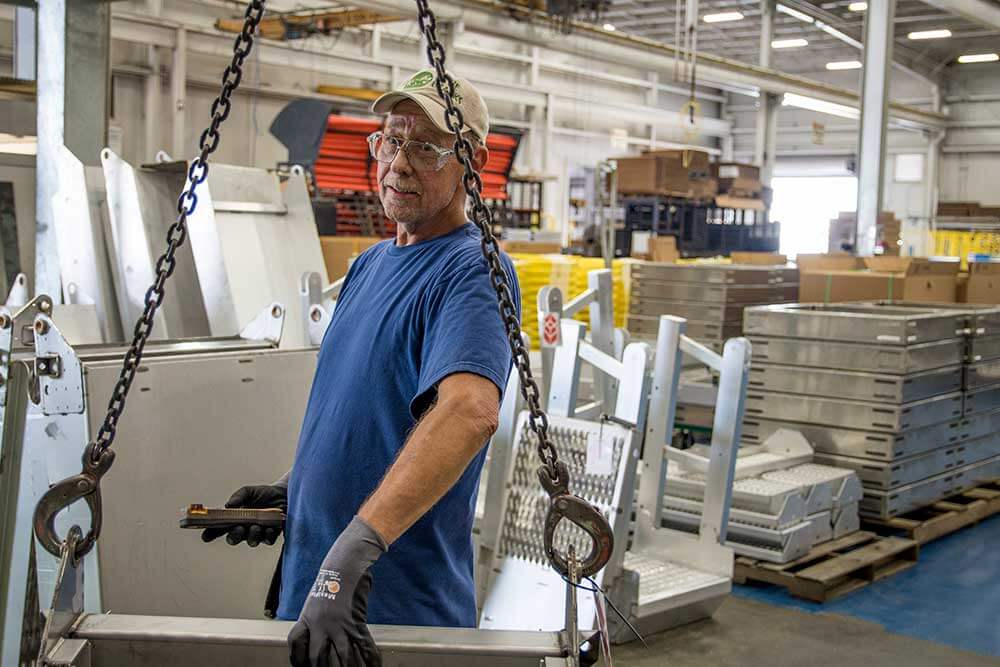
Another very important function performed by access catwalks which also go by the name of catwalk mezzanines is to allow optimal utilization of space within the confines of an industrial building. Any building or facility that has a ceiling height that is greater than 15 feet can have a mezzanine installed within its cube. If the height is as much as 30 feet one can have a multi-level mezzanine system installed. Installing a catwalk is also beneficial from a safety point of view. The fact that these need to conform to the strictest safety norms, as mandated by OSHA. In particular, fall protection is something that is given top priority. Not only does that keep the workers safe, but it also prevents companies from facing lawsuits on account of workplace accidents. That apart they will be able to avoid incurring huge fines levied by OSHA for noncompliance. A Maine roofing contractor, for example, had to pay a fine of $1.792 million on account of an incident that resulted in a worker fatality.
What Determines Catwalk Design
There are several inputs required when it comes to determining a catwalk design. Let’s take a look at what these might be-
Before one gets down to designing the required catwalk it makes eminent sense to ask for a detailed brief that incorporates the essential elements of the required catwalk system. It goes without saying that the more detailed the brief the better the catwalk design.
One needs to consult the structural drawings of the facility where the catwalk has to be installed because the catwalk would need to be attached to its structure. The drawings could be in the shape of a hand-drawn drawing or an auto cad one. Details about the positioning of the catwalk vis-à-vis the primary steel or spacing of the principal structure need to be known beforehand in case it is to be hung from steel beams or joists. As this has an impact on the safety of the structure, its importance cannot be understated.
It is important to know details about the elevations of the principal structure, as also the required elevation of the walkway surface. That will help in designing and installing the catwalk in accordance with the exact needs of a facility.
This information is critical for functionality. The design of the catwalk will principally depend upon the kind of use that it will be put to. Again, this information is critically important since it also has a bearing on the safety of the structure.
Components of Access Catwalk System
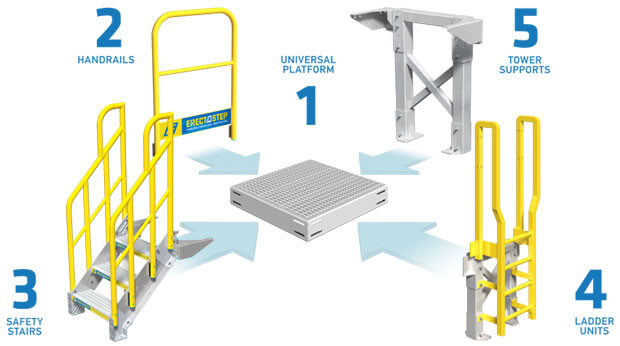
A typical access catwalk system comprises more than just the walkway. It is put together with the help of the following prefabricated components:
- Universal Platforms – These are often constructed with aluminum and are equipped with positive traction walk surfaces. Each unit has common bolt hold patterns to help make it compatible with stairs, handrails, and other surfaces.
- Tower Support – These six-step towers can be interconnected with one another and may come in three variants-single tower & single platform, single tower and two platforms, and tower support for multiple platforms allowing one tremendous flexibility in designing catwalk systems.
- Handrails – These are prefabricated and come equipped with universal nut plate inserters. The handrails are powder coated and made out of aluminum.
- Metal Stairs – These 6 step stairs can be interconnected and may have a platform surface of 63 inches and a platform clearance of 57 inches. A 26-inch positive traction surface is prefabricated in a manner that makes it compatible with any side of the platforms.
Types of Catwalks and Their Configurations
As the conditions at various worksites vary considerably, different types of access catwalks may suit the specific requirements of a particular place. Given below are some of the most popular types of catwalks in use at worksites-
Preassembled Catwalks
These are ideal for things like material handling and a variety of other industrial applications. These are also called elevated catwalks and conform to the regular conveyer section length of 12 feet. The width comes in configurations of 24, 30, and 36 inches. As one might imagine the biggest advantage of this type of catwalk is its convenience on account of easy to install property. This is facilitated by a simple 4 bolt connection. If one requires a shorter span length, one can resort to shortening them at the worksite. We also call these crossover stairs.
Customized Catwalks
Wherever it is not feasible to use preassembled access catwalks, one can order customized ones. These can be constructed according to the exact configurations demanded by the clients. These customized catwalks are of great use in different kinds of settings and work environments. These could, for instance, facilitate material handling and provide access to all manner of industrial equipment.
Easy-to-Assemble Aluminum Catwalks
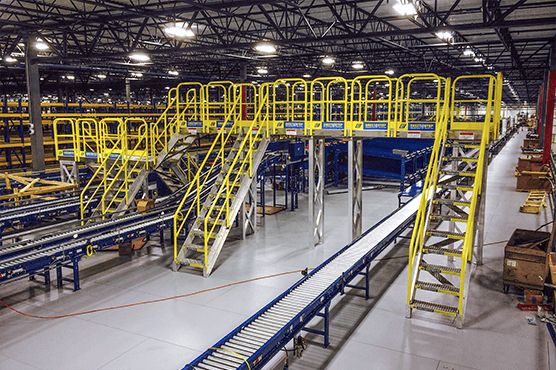
These are highly durable easy to assemble catwalks owing to their being shipped in the shape of easy to assemble modular components. These come with a maximum height of 8 feet and nine inches, a maximum length of 13 feet and 8 inches, a maximum width of 3 feet and four inches, and a maximum clearance of five feet and three inches.
Steel Catwalks
Steel catwalks are great for providing equipment and machinery access in the trickiest of situations. These are designed using the bolt-together system that can easily extend from one side of the facility to another. Such access catwalks have several uses in industrial settings and can be custom-built according to specific requirements. These are ideal both for reducing foot traffic in a facility as well as for being used as a platform to help run a conveyor system across it.
Fiberglass Grating Catwalks
Unlike steel fiberglass grating catwalks don’t risk corrosion due to environmental conditions. Fiberglass grating platforms are not only resistant to corrosion, but they are also lightweight and therefore easy to install. These types of catwalks are virtually maintenance-free and capable of handling heavy foot traffic. These can easily last as long as two decades. What’s more, these catwalks can be modified as per need. For example, they can be made to withstand higher temperatures or given anti-slip surfaces. Besides, fiberglass catwalks don’t need any foundation fortification, specialist machinery, or special tools to help install.
Fall Protection and OSHA Standards
Access catwalks that are also known as mezzanine catwalks can be very hazardous for worker safety in the absence of adequate safety precautions. This is mainly on account of the danger of workers falling off an unprotected access catwalk. This makes it necessary for fall protection systems to be put into place. OSHA or the Occupational Safety and Health Administration has prescribed certain mandatory standards to be followed when it comes to the installation and use of catwalks. These are as follows:
Preventing skipping, dropping, and slipping
All catwalks need to be covered with a nonskid surface. Alternatively, it can be made from a nonskid grating. The purpose of this regulation is to prevent falls due to slipping. That apart the toe boards have to be 3 and a quarter inches tall on the open sides to prevent tools from falling down and hurting people below.
Precautions Against Fall Injuries
To ensure that no worker dies or is injured due to a fall from a catwalk, OSHA has mandated that all catwalks that are four feet or higher need to be made secure with the help of guardrails that are approximately 42 inches tall around their perimeters. These could be as short as 39 inches and reaching a maximum of 45 inches. The 45 inches height limit could be surpassed in the event of the guardrail meeting all other OSHA guardrail specifications.
In cases where the platform does not happen to be between walls or parapets that are at least 21 inches tall, the guardrails need to be fitted with mid-rails, screens, vertical panels or any other suitable barrier between the top rail and the platform. The guardrail itself must be such that it can bear a weight up to 200 pounds exerting downward or outward force within 2 inches of the top rail.
If a force of up to 200 pounds is applied to the top rail, it should not deflect to a height that is lower than 39 inches above the platform. Other than that vertical panels, meshes or any other type of intermediary barrier should be strong enough to bear a force of up to 150 pounds that is applied downward or outward. The top, as well as the mid-rails, need to be at least one-quarter inch in diameter.
The protection provided by OSHA to construction workers in case guardrails is not enough to mandate that a fall resistant and fall arrest system that compliant with their standards will be put in place wherever they are working at a fall height that is greater than 6 feet. Fall resistant systems are so designed that they prevent workers from falling off catwalks, while fall arrest systems prevent, as the word suggests break the workers’ fall and keep them from crashing to the ground and grievously hurting themselves.
Structural Requirements
OSHA prescribes that a catwalk platform cannot exceed four times its width. OSHA 1910 calls for minimum tread width of 22” & maximum rise of 9 1/2” Catwalks are also required to have self-closing safety gates to ensure that workers don’t fall through the openings.
Walking Surfaces
It is mandated that all walking surfaces have to be equipped with nonskid surfaces or grating. It is further required that footboards be used to prevent tools and materials from falling on to the work areas below.
Supports
Whether a catwalk is moored to the ground or suspended from the ceiling, it will have to conform to OSHA standards and specifications. All catwalks have to be equipped with railings that can withstand up to 200 pounds of pressure. That apart, the exit should be by way of permanent structures like stairs and attached ladders.
Training
A comprehensive training program to apprise employees of the possible fall hazards and how to prevent them from occurring. The training is to incorporate information about the correct methodology for erecting, maintaining, removing, and inspecting the fall protection systems. They should also be taught the use of control access zones-guardrail, personal fall arrest, warning line, safety net, and other safety warning systems. Every worker needs to be apprised of their role in the safety monitoring system in place. They also need to be trained in following the right procedures about material and equipment handling and storage and the installing of overhead protection.
Catwalk Applications and Solutions
No large industrial site would look like one of it didn’t have catwalks crisscrossing it. They connect buildings, go over machinery, provide access to workstations and make maintenance possible. Whether it is conveyor systems, process machinery, monitoring devices, building mechanicals, or service areas catwalks allow easy access to all of these.
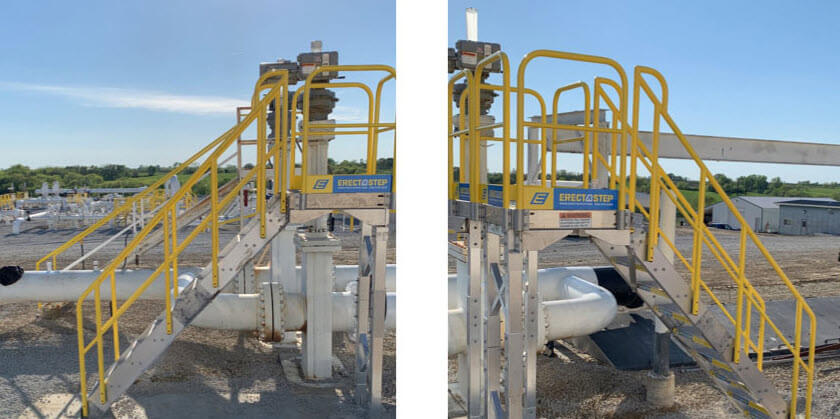
Erectastep has installed a catwalk at a pipeline in Bethany, Missouri. They also provided a unique solution for a dairy plant in which workers found it difficult to load and unload their milk trucks. They did so by providing a double-sided platform that helped them minimize the risks caused to the safety of their workers by the earlier system being followed.
Prominent among the sectors that see catwalks being used extensively is warehousing. A well-organized warehouse usually sees conveyors and sorting systems in use. It is necessary to ensure that such systems are properly maintained to ensure their smooth functioning. The only way to do that is to gain access to these without interrupting work and the best way to do that is by using catwalks. These provide easy access to conveyor systems and warehouse racking as well as industrial shelving units without in any way interrupting the flow of work and thereby helps avoid costly downtime.
Maximizing Space
One of the most important applications of catwalks would be their ability to maximize the utilization of space at a facility. These can help double the amount of space that a facility has access to. Besides, they can also help one use interstitial space which otherwise would go unutilized by converting it into an overhead maintenance catwalk walkaway zone. What’s more, this does not even necessitate any additional construction. On an oil rig, well-designed catwalks can considerably lessen tubular handling and greatly reduce operating hazards creating a much safer work environment.
Steel catwalks, in particular, lend themselves to multiple applications. They see use in not just industrial facilities, but also military facilities, manufacturing plants, commercial buildings, and correctional facilities. Industrial and manufacturing plants more often than not need an extensive network of catwalks. Steel catwalks are preferred because these provide the much-needed overhead stability that enables access to materials and machinery like tanks, processing equipment, silos, sortation systems, hoppers, and so on.
Enhancing Observation and Convenience
The functional value provided by steel catwalks is indeed phenomenal. Overhead catwalks, for example, are known to enhance observation capability, increase floor space and provide convenient access to materials and equipment required to smoothly run operations. There is an endless array of operations that a catwalk can facilitate. For instance, a beverage company may use a catwalk to prevent the jamming of conveyor lines. Those catwalks can lend themselves to diverse uses that can be understood by the fact that one can attach lights under a catwalk to give enough lighting to pull out records. Another use that industrial catwalks are put to is providing access to attic spaces or above clean.
Using an existing mezzanine in one’s facility like a catwalk is a very efficient, economical, and eminently practicable solution to provide point-to-point access within your facility, without interrupting work on the floor of the facility. One can consult with leading manufacturers and suppliers of catwalks and mezzanines to design and erect bespoke catwalks catering to specific needs and requirements. The advantage of using mezzanines is that they can also be used as work platforms, storage, and office spaces as well as a work platform.
Conclusion
Access catwalks and mezzanines are not only an integral part of the industrial and commercial landscape, but they also provide a slew of operational, logistical and economic advantages that positively impact the bottom lines of business. Perhaps the greatest advantage of catwalks and mezzanines is their tremendous flexibility of use. They not only enhance worker efficiency but also their safety and security creating a win-win situation for all. This is something that has become even more pronounced in the digital age what with better designing capabilities extending the possibilities about how catwalks and mezzanines are going to be deployed. The days ahead can see many more innovatively designed catwalks and mezzanines being deployed by more and more businesses, commercial enterprises, and institutions.
